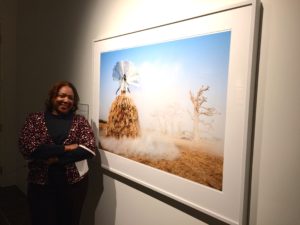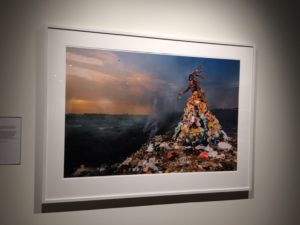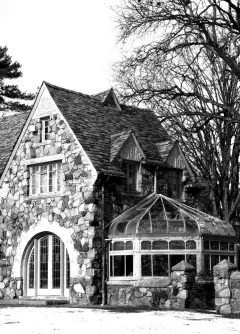By Harold C. Ford
“It is our responsibility to visit studios and to seek out artists who are often overlooked because of their racial and ethnic backgrounds.” …Irena Jurek, visual artist, Huffington Post, Nov. 17, 2016
MW Gallery, located in the heart of downtown Flint at the corner of Saginaw and Court Streets, is the permanent home of the Mott-Warsh Collection (MWC). Promoting “cutting-edge art”, Flint’s newest art venue opened to the public in June of 2016. A new exhibit titled “Where Do We Go From Here?” opened Jan. 13.
The Mott-Warsh Collection, according to MWC’s website, “was established in 2001 by Maryanne Mott and her late husband, Herman Warsh. MWC features the work of artists of the African diaspora and those who reflect on it. It comprises over 600 works by more than 185 artists working in varied media and stylistic approaches.”
“Where Do We Go From Here?” is inspired by recent political events in the United States, according to Maryanne Mott, the daughter of Charles and Ruth Mott and the gallery’s namesake. Mott told East Village Magazine the exhibit “has many sources of inspiration but certainly the current political climate was a strong factor. We hope that it will prompt curiosity, reflection and discussion.”
“It is” a response to “the elephant in the room,” conceded Stephanie James, MW Gallery’s director, curator, and collection educator in an interview with EVM.
“To be honest,” James said, “I had another theme in mind coming into time for the changeover (of the exhibits), but I really felt because there was so much going on, so much anxiety from all directions, frustrations that led to our current president being put into place.”
James acknowledged that, “we, as a society, are going through a difficult time right now in trying to understand one another, hear one another out.” She offered the exhibit as “an opportunity to reflect on some of these issues through the artists’ reflections.”

MW Gallery curator Stephanie James with “Prophecy: Untitled #9” © Fabrice Monteiro.
“It’s ironic that, while much of this work seems to come out of yesterday’s headlines, some of it is over 50 years old (such as) the photojournalists’ work on the civil rights movement,” James observed. “So many of those shots you could just imagine having taken during one of the Black Lives Matter movements (or) the Women’s March on Washington.”
Others are more blunt in their assessment about the intersection of the arts with wealth and power in the age of Trump.
“The Orangeman looms large in the collective creative imagination,” asserted Jason Rhode in a January, 2017 article for Paste Magazine. “All of this is understandable, even predictable: the necessary, healthy backlash by a progressive cultural bloc against the likelihood of a reactionary Presidency.”
That wealth, power, and art are interconnected in the human experience is virtually inarguable. “Additionally, because patrons are important for artists, art has always commented on wealth or influence,” Rhode wrote. “Whether praising it, or critiquing it, art is inherently concerned with power. At its best, this includes patrons like the Medicis of Florence backing the works of the Renaissance giants.”
The Medicis were among the most powerful and influential families in the history of western civilization. This Italian banking and textile manufacturing family morphed into a royal house and political dynasty that contributed three popes to the Roman Catholic Church. Centered in Florence, the Medicis’ wealth and power sustained an environment where art and humanism could flourish.
The Medicis and their embrace of humanitarian art inspired the birth of the Renaissance (14th-17th centuries), deemed by many historians to be the cultural bridge between the Medieval period and the Early Modern Age. Alternative sources of funding, like that offered by the Medicis, allowed more artists to explore artistic expressions beyond the thematic restrictions imposed by a wealthy and powerful Roman Catholic Church.
The interconnection of wealth, power, and art was true in yesteryear; and it’s true today. “In our own era, this usually takes the form of the public funding creative work through direct purchase,” wrote Rhode. “When we buy a ticket to a Scorsese movie, we don’t think of ourselves as playing the role of a Rockefeller funding a filmmaker, but in effect, that’s what we’re doing,” he continued. “Bernini had Pope Urban VIII as his patron; The Pixies had the American consumer.”
Flint has Maryanne Mott, Herman Warsh, and the MW Gallery.
“My connection to social justice came largely from many sources, including values to which I was exposed at St. Paul’s Episcopal Church both in the formal service and discussions in Sunday school,” Mott told EVM. Other sources included “my mother’s quiet but active and compassionate concern for others less fortunate, conversations with Dr. Art Tuuri, and the dissonance I felt between my family’s circumstances, privilege and prominence and those of others.”
She said of her late husband: “Herman’s commitment to social justice, I believe, emerged from the strong social justice values of his immigrant parents, growing up poor, and being a bright, curious and questioning student of current events as well as history.”
The role of artists—and their patrons—during times of political and social tension is critical. Tony Morrison supported this notion in a recent piece for Nation Magazine: “Dictators and tyrants routinely begin their reigns and sustain their power with the deliberate and calculated destruction of art: the censorship and book-burning of unpoliced prose, the harassment and detention of painters, journalists, poets, playwrights, novelists, essayists. This is the first step of a despot whose instinctive acts of malevolence are not simply mindless or evil; they are also perceptive. Such despots know very well that their strategy of repression will allow the real tools of oppressive power to flourish.”
Here is a list of leaders who have called the press the enemy of the people:
- Friday, Feb. 24: At the Conservative Political Action Conference, President Donald Trump said of the American press, “They are the enemies of the people.”
- 2000s: Venezuela’s strongman Hugo Chavez called political dissenters “enemies of the homeland”.
- 1970s: In a taped phone conversation, former US president Richard Nixon said, “The press is your enemy…Because they’re trying to stick the knife right in our groin.”
- Mid-1900s: China’s Mao Zedong called his critics “enemies of the people.”
- Mid-1900s: Any critic of Josef Stalin’s rule could be labeled as “unpatriotic…enemy of the state.”
In her Nation piece, Morrison warned: “This is precisely the time when artists go to work. There is no time for despair, no place for self-pity, no need for silence, no room for fear. We speak, we write, we do language. That is how civilizations heal…Like failure, chaos contains information that can lead to knowledge—even wisdom. Like art.”
Like art. Indeed. Like the art you’ll find right now at MW Gallery. Some samples:
“I Feel Most Colored”, 1992, by Glenn Ligon, b. 1960, etching on BFK paper:

“I Feel Most Colored” 1992 ©Glenn Ligon
What appears to be lined paper is glass-encased in an approximate 2 foot by 3 foot frame. [technically, paper isn’t lined] Printed on the lined paper is the sentence, “I feel most colored when I am thrown against a sharp white background…I feel most colored when I am thrown against a sharp white background…”, repeated line after line, finally disappearing into a smudged, indistinguishable nothingness at the bottom of the page. The sensitive student of Ligon’s piece might swallow hard in response to his representation of what happens to blackness, or “colored”, in a white-dominant society. Or, one might conjecture about the ramifications of miscegenation in America.
Ligon offers the visitor to his piece a confident, insightful, and generous reflection considering the context of the times in which we live: “My country, right or wrong. Sometimes, I feel discriminated against, but it does not make me angry. It merely astonishes me. How can any deny themselves the pleasure of my company? It’s beyond me.” A companion piece by Ligon with a similar presentation is titled “I Do Not Always Feel Colored.”
“Decide Who You Are #6; You’r History,” 1992, Adrian Piper, b. 1948, multimedia:
“You’r History” is a tour de force, seven-piece presentation that deserves time and patience and a left-to-right exploration that seems to be chronological. The first panel begins your journey into Piper’s work: “You’r history, a discontinued discount, that’s the shelf where they’d find you, ripped out of your natural habitat, dropped onto an alien planet, broken into useful pieces…”
Your journey ends with the last panel, sort of, with the image of a little black girl that probably integrated an all-white school, someone like Ruby Bridges, surrounded by all-too-familiar racist rationalizations: “I don’t know what you mean. I didn’t notice anything wrong. It seems fine to me. It wasn’t intentional. Just calm down. I just can’t relate. You’re making too much of this.” And on, and on, ad infinitum; a piece of art about excuses that are centuries in the making.
The little girl in the last panel, James said, is actually Anita Hill.
“The Prophecy, Untitled #1” project, 2013, Fabrice Monteiro, b. 1972:

Prophecy: Untitled #1″ project, 2013, ©Fabrice Monteiro
From afar, Monteiro’s piece is dominated by a tall and stunning human figure, cloaked in colorful garments, atop, atop…getting closer, coming into focus…a mountain of refuse! And the tall, likely African, woman is wrapped in a long, flowing garment of interwoven trash: plastic bottles, packaging materials, plastic bags, a large skillet, used snack bags, brown paper. Her head is covered with a black, tar-like substance; her hair features freakishly long braids interwoven with refuse, extending in all directions from the crown of her head. She is adorned with colorful necklaces and bracelets, also made of refuse.
According to the description that accompanies the piece, Monteiro’s project is “informed by the critical environmental problems that plague many parts of the African landscape (that feature a) harrowing series of photographs to visually represent the urgent ecological issues.” The stunning “prophecy” project photos were shot at ten locations in Senegal. His work may remind you of Tyree Guyton’s “Heidelberg Project” in Detroit. A review on the website DesignBoom.com states the figure is positioned in Senegal’s largest waste dump, once a green marsh district, where the land still provides space for “a marginalized part of the population with its own laws and territorial demands, despite all the prevailing adverse condition.”
“From the Cabinet: Squall”; Radcliffe Bailey, b. 1968, mixed media:
Perhaps the most disquieting of the pieces in the current MW Gallery exhibit, Bailey’s dark, brooding “Squall” includes piano keys that are meant to be an homage to musicians like Thelonius Monk, Sun Ra, and Duke Ellington. “Squall” is the artist’s brutal representation of the African diaspora, a frequent theme of his artwork.
“Lakesha, Jackie, and Crystal,” 1996, Dawoud Bey, b. 1953, Polacolor ER print:

“Lakesa, Jackie and Crystal” 1996 © Dawoud Bey
“Lakesha, Jackie, and Crystal” is an eight-panel photographic representation of three girls that could very well be Flint natives. The work is a tender, loving portrait of three girls that appear pensive, perhaps forlorn as if during the wake of a kinsman. The three are clearly connected and supportive of one another: Lakesha’s hand is resting on the shoulder of Jackie; Jackie’s shoulder is supporting Crystal’s head. The piece is a larger than life and a dignified representation of youth.
Bey’s accompanying biographical information informs the visitor that “he uses his artwork as a platform to challenge stereotypical images of African Americans and other historically marginalized groups.” He has endeavored “to broaden the participation of various people whose voices have often been absent in these (art) institutions.”
The “absent voices” referenced by Bey are likely present in the current exhibition at MW Gallery. That would include the voice of America’s diminished labor movement, featuring the contributions of women, in Michele Tejoula Turner’s 2008 work, “1936-37 Sit-Down Strike and the Women’s Brigade” as represented on a painted gourd. Nonetheless, it is the “voices’ of African-American artists that are most evident in “Where Do We Go From Here?”
According to Maisha Kai in The Root: “Historically, moments like the one in which we currently find ourselves are those in which black art, in particular, thrives in America. Not discounting the incalculable artistry that emerged prior to and during slavery—or more accurately, in spite of it—it’s indisputable that the rise of black art in America has almost always been directly correlative to the adversities facing the black American.”
“As Bryan Mason, one-half of interior design duo AphroChic, noted in “The Case for Black Art,” “Black art has always been political…everything has been a troublesome moment for us.”
MW Gallery is open Thursdays and Fridays, 11:00 a.m. to 6:00 p.m.; Saturdays, 11:00 a.m. to 5:00 p.m.; 2nd Friday of each month, 11:00 a.m. to 9:00 p.m. In her interview with EVM, Maryanne Mott exclaimed, “Visitors welcome!”
* * * * *
Editor’s note: The reader should know that Harold C. Ford, the writer of this article, has had an association with Maryanne Mott and her late husband Herman Warsh since October of 2000. It began on a professional basis but Ford says he would like to believe that it evolved into a friendship over the years. The relationship started when Mott and Warsh gave Ford the opportunity to build a scholarship program for students in the Beecher School District supported by funds from the newly-created Ruth Mott Foundation, now Flint’s second largest foundation. At a press conference that announced the inaugural RMF-funded projects, Ford described Mott and Warsh as “blue bloods with a blue collar orientation”.
O God of black and brown and white and albino children
and those all mixed together
O children who are rich and poor and in between
Of children who speak English and Russian and Hmong and
Spanish and Chinese and Hebrew and Arabic languages
our ears cannot discern
Help us to love and respect them all.
…from “A Prayer to the God of All Children” by Marian Wright Edelman; from a book given as a gift to Ford by Herman Warsh many years ago.
Staff writer Ford can be reached at hcford1185@gmail.com. Photos by Jan Worth-Nelson taken with permission of the artists and MW Gallery.


You must be logged in to post a comment.